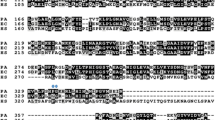Abstract
Experiments were designed to determine the role of heme and the importance of other factors in the growth ofCampylobacter pylori. Campylobacter pylori strains were tested for their ability to synthesize porphyrin, for their ability to grow and be maintained on basal medium and basal medium supplemented with blood or blood products, and for the influence of bovine serum albumin and catalase on viability. Results indicated thatCampylobacter pylori does not require heme as a source of porphyrin. Growth ofCampylobacter pylori could not be sustained on media containing starch or hemoglobin, but was sustained on media containing erythrocytes, serum, bovine serum albumin or catalase. The ability to grow on media containing bovine serum albumin and catalase suggests that protection from toxic fatty acids and the prevention of toxic product formation may be important factors in the growth and survival ofCampylobacter pylori in vitro. Both bovine serum albumin and catalase combined provide the minimum requirements which allow the spectrum ofCampylobacter pylori present in a single culture to grow on blood-free media.
Similar content being viewed by others
References
Megraud, F., Bonnet, F., Garnier, M., Lamouliatte, H. Characterization ofCampylobacter pyloridis by culture, enzymatic profile, and protein content. Journal of Clinical Microbiology 1985, 22: 1007–1010.
McNulty, C. A. M., Dent, J. C. Rapid identification ofCampylobacter pylori (Campylobacter pyloridis) by preformed enzymes. Journal of Clinical Microbiology 1987, 25: 1683–1686.
Mobley, H. L. T., Cortesia, M. J., Rosenthal, L. E., Jones, B. D. Characterization of urease fromCampylobacter pylori. Journal of Clinical Microbiology 1988, 26: 831–836.
Ferrero, R. L., Hazell, S. L., Lee, A. The urease enzymes ofCampylobacter pylori and a related bacterium. Journal of Medical Microbiology 1988, 27: 33–40.
Marshall, B. J., Royce, H., Annear, D. I., Goodwin, C. S., Pearman, J. W., Warren, J. R., Armstrong, J. A. Original isolation ofCampylobacter pylori from human gastric mucosa. Microbios Letters 1984, 25: 83–88.
Hazell, S. L., Lee, A., Brady, L., Hennessy, W. Campylobacter pyloridis and gastritis: association with intercellular spaces and adaption to an environment of mucus as important factors in colonization of the gastric epithelium. Journal of Infectious Disease 1986, 153: 658–663.
Buck, G. E., Smith, J. S. Medium supplementation for growth ofCampylobacter pyloridis. Journal of Clinical Microbiology 1987, 25: 597–599.
Kilian, M. A rapid method for the differentiation ofHaemophilus strains. Acta Pathologica, Microbiologica Scandinavica 1974, 82: 835–842.
Burnham, B. F., Neiland, J. B. Studies on the metabolic function of the ferrichrome compounds. Journal of Biological Chemistry 1961, 236: 554–559.
Lascelles, J. Synthesis of tetrapyrroles by microorganisms. Physiological Reviews 1961, 41: 417–441.
Myers, W. F., Osterman, J. V., Wisseman, C. L. Nutritional studies ofRickettsia quintana: nature of the hematin requirement. Journal of Bacteriology 1972, 109: 89–95.
Mauzerall, D., Granick, S. The occurrence and determination of d-aminolevulinic acid and porphobilinogen in urine. Journal of Biological Chemistry 1956, 219: 435–446.
Dubos, R. J., Middlebrook, G. Media for tubercle bacilli. American Review of Tuberculosis 1947, 56: 334–345.
Miles, A. A., Misra, S. S. The estimation of the bactericidal power of the blood. Journal of Hygiene 1938, 38: 732–748.
Mellencamp, M. W., McCabe, M. A., Kochan, I. The growth-promoting effect of bacterial iron for serum exposed bacteria. Immunology 1981, 43: 483–491.
Knapp, H. R., Melly, M. A. Bactericidal effects of polyunsaturated fatty acids. Journal of Infectious Disease 1986, 154: 84–94.
Author information
Authors and Affiliations
Rights and permissions
About this article
Cite this article
Hazell, S.L., Markesich, D.C., Evans, D.J. et al. Influence of media supplements on growth and survival ofCampylobacter pylori . Eur. J. Clin. Microbiol. Infect. Dis. 8, 597–602 (1989). https://doi.org/10.1007/BF01968136
Issue Date:
DOI: https://doi.org/10.1007/BF01968136




